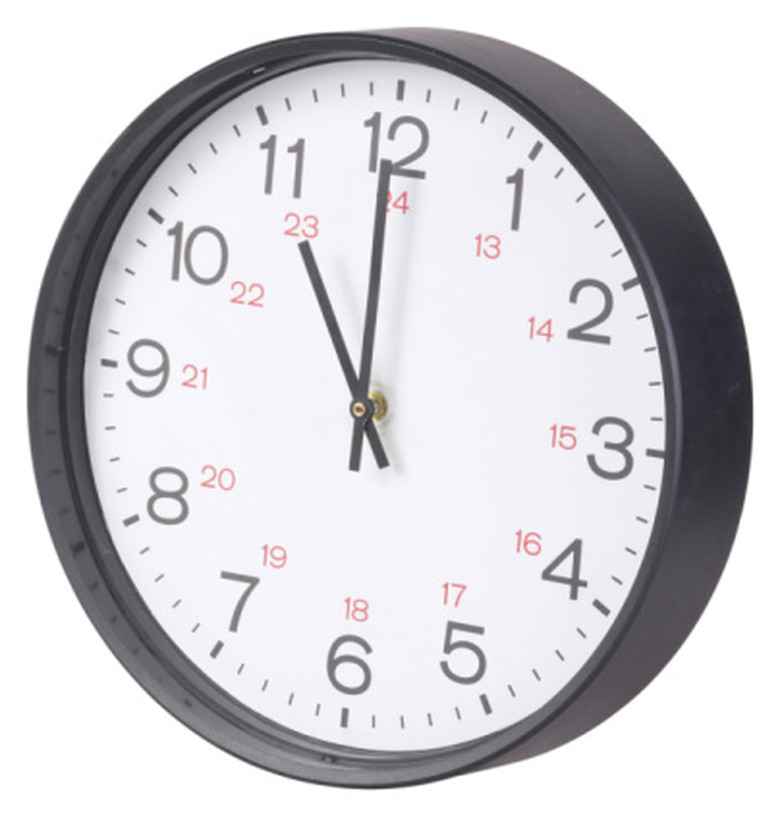How To Convert Minutes To Percentages
When it comes to comparing portions of a whole, the percentage is a universal, easy-to-understand measure that puts everything into perspective. So if, for example, you want to know how much time out of the day you spend studying versus how long you spend playing video games, you could convert the minutes of both study and play into percentages.
TL;DR (Too Long; Didn't Read)
To convert minutes into percentages, divide the measured number of minutes by the "total" minutes possible:
**minutes ÷ total minutes = percentage**
How to Convert Minutes to Percentage
How to Convert Minutes to Percentage
If you want to calculate the percentage of anything at all, you divide the measured portion by the total quantity from which that portion is taken. There's just one catch: Both the measured portion and the total quantity must be in the same unit.
**Example 1:** Imagine that you spent 45 minutes of a two-hour study period secretly playing video games. What percentage of the study period did you spend on the games?
Your first step is to convert the "total quantity" – in this case, two hours – into minutes. There are 60 minutes in an hour, so during that two-hour period there were 60 × 2 = 120 minutes available to you.
Now that both your time spent playing and the total time available are in the same unit, all you have to do is divide the time spent playing (45 minutes) by the total time (120 minutes):
\(\frac{45}{120} = 0.375\)
The result is a percentage, but it's written in decimal form. To write your answer in percentage form, multiply the decimal by 100:
\(0.375 × 100 = 37.5\%\)
So you spent 37.5% of your study time playing games.
TL;DR (Too Long; Didn't Read)
Did you notice that multiplying by 100 is the same as moving the decimal point two places to the right? This shortcut comes in very handy with percentage problems.
Another Example of Converting Minutes to Percentage
Another Example of Converting Minutes to Percentage
What about converting minutes into a percentage out of a longer span? Let's take those 45 minutes of time spent on video games and see what percentage of your total day they represent.
As before, your first step is to convert your total quantity – in this case, the total time in a day – into minutes. There are 24 hours in a day, and each one of those hours is 60 minutes long. So your day is:
\(24 × 60 = 1440 \text{ minutes long}\)
Now you're ready to divide your observed time or partial quantity (in this case, 45 minutes) by the whole, which gives you the following percentage in decimal form:
\(\frac{45}{1440} = 0.03125\)
To convert that decimal into percentage form, multiply it by 100:
\(0.03125 × 100 = 3.125\%\)
So in all, you spent 3.125% of that day playing video games.
TL;DR (Too Long; Didn't Read)
You may have noticed that you can always plug your data into an online time percentage calculator (see Resources) and get an answer that way. But knowing how to do your own percentage calculations will be very important in future math classes, and your teacher probably won't let you go online to use calculators then.
Also, percentages are one of the math skills that you're most likely to find yourself using in real life. For example, you might walk up to a sale rack and see clothes that are on sale for 30% off the last marked price. The more you practice working with percentages now, the easier it'll be to calculate that sort of thing on the fly.
Cite This Article
MLA
Maloney, Lisa. "How To Convert Minutes To Percentages" sciencing.com, https://www.sciencing.com/convert-minutes-percentages-8649936/. 22 December 2020.
APA
Maloney, Lisa. (2020, December 22). How To Convert Minutes To Percentages. sciencing.com. Retrieved from https://www.sciencing.com/convert-minutes-percentages-8649936/
Chicago
Maloney, Lisa. How To Convert Minutes To Percentages last modified March 24, 2022. https://www.sciencing.com/convert-minutes-percentages-8649936/
